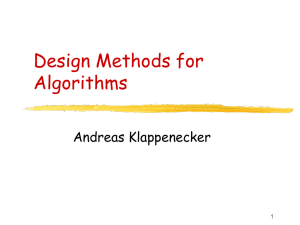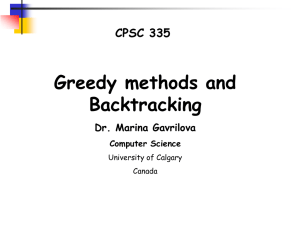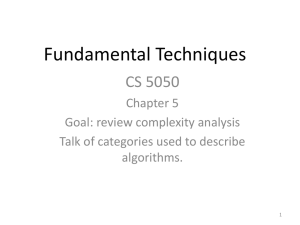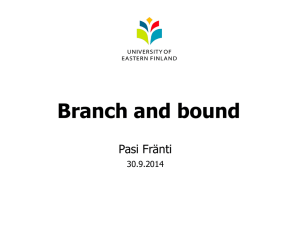My Lecture Notes II
advertisement
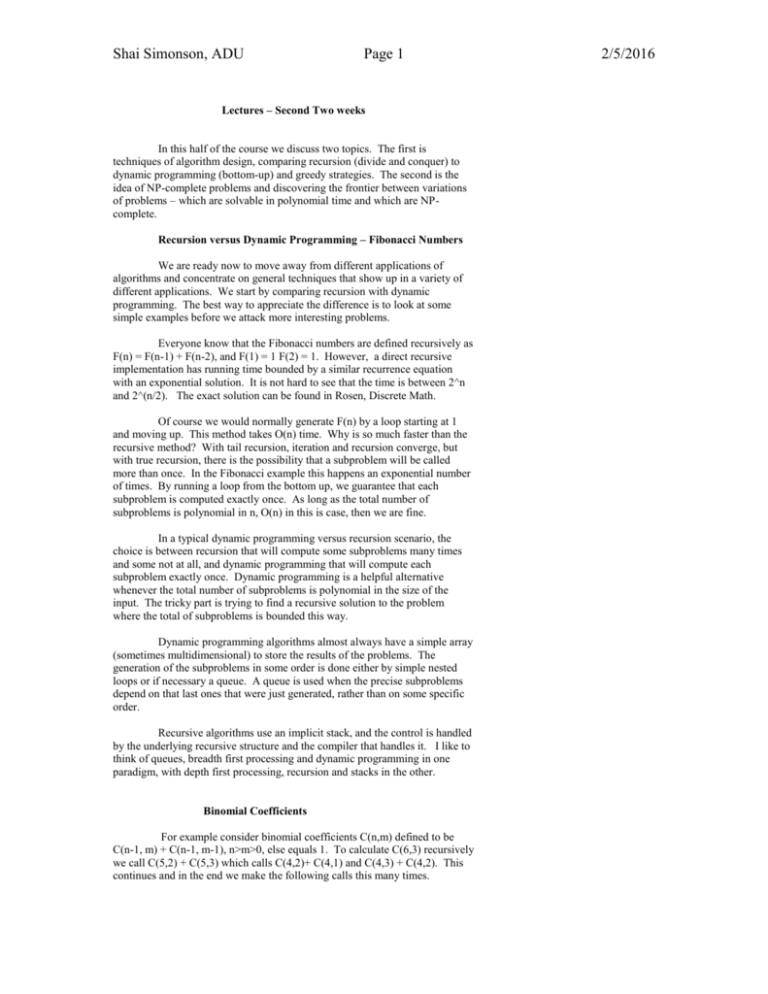
Shai Simonson, ADU
Page 1
Lectures – Second Two weeks
In this half of the course we discuss two topics. The first is
techniques of algorithm design, comparing recursion (divide and conquer) to
dynamic programming (bottom-up) and greedy strategies. The second is the
idea of NP-complete problems and discovering the frontier between variations
of problems – which are solvable in polynomial time and which are NPcomplete.
Recursion versus Dynamic Programming – Fibonacci Numbers
We are ready now to move away from different applications of
algorithms and concentrate on general techniques that show up in a variety of
different applications. We start by comparing recursion with dynamic
programming. The best way to appreciate the difference is to look at some
simple examples before we attack more interesting problems.
Everyone know that the Fibonacci numbers are defined recursively as
F(n) = F(n-1) + F(n-2), and F(1) = 1 F(2) = 1. However, a direct recursive
implementation has running time bounded by a similar recurrence equation
with an exponential solution. It is not hard to see that the time is between 2^n
and 2^(n/2). The exact solution can be found in Rosen, Discrete Math.
Of course we would normally generate F(n) by a loop starting at 1
and moving up. This method takes O(n) time. Why is so much faster than the
recursive method? With tail recursion, iteration and recursion converge, but
with true recursion, there is the possibility that a subproblem will be called
more than once. In the Fibonacci example this happens an exponential number
of times. By running a loop from the bottom up, we guarantee that each
subproblem is computed exactly once. As long as the total number of
subproblems is polynomial in n, O(n) in this is case, then we are fine.
In a typical dynamic programming versus recursion scenario, the
choice is between recursion that will compute some subproblems many times
and some not at all, and dynamic programming that will compute each
subproblem exactly once. Dynamic programming is a helpful alternative
whenever the total number of subproblems is polynomial in the size of the
input. The tricky part is trying to find a recursive solution to the problem
where the total of subproblems is bounded this way.
Dynamic programming algorithms almost always have a simple array
(sometimes multidimensional) to store the results of the problems. The
generation of the subproblems in some order is done either by simple nested
loops or if necessary a queue. A queue is used when the precise subproblems
depend on that last ones that were just generated, rather than on some specific
order.
Recursive algorithms use an implicit stack, and the control is handled
by the underlying recursive structure and the compiler that handles it. I like to
think of queues, breadth first processing and dynamic programming in one
paradigm, with depth first processing, recursion and stacks in the other.
Binomial Coefficients
For example consider binomial coefficients C(n,m) defined to be
C(n-1, m) + C(n-1, m-1), n>m>0, else equals 1. To calculate C(6,3) recursively
we call C(5,2) + C(5,3) which calls C(4,2)+ C(4,1) and C(4,3) + C(4,2). This
continues and in the end we make the following calls this many times.
2/5/2016
Shai Simonson, ADU
C(6,3) – 1
C(5,3) – 1
C(5,2) – 1
C(4,3) – 1
C(4,2) – 2
C(4,1) – 1
C(3,3) – 1
C(3,2) – 3
C(3,1) – 3
C(3,0) – 1
C(2,2) – 3
C(2,1) – 5
C(2,0) – 3
C(1,1) – 6
C(1,0) – 6
Page 2
*
*
*
*
*
*
The calls with stars are bottom level calls which return 1, and the sum
of these is C(6,3) = 20. Note that we do NOT call every possible subproblem.
In particular, C(6,4), C(5,1), C(4,0) among many others are never called at all.
Nevertheless, if you analyze the recurrence equation we get T(x) =
T(x-1) + T(x-2), where x = m+n, and this is the same as the bad Fibonacci time
algorithm of the previous paragraph.
There is of course a faster way to compute binomial coefficients from
the bottom up and it generates Pascal’s triangle through the nth row.
For j = 1 to n {B(j, 0) = B(j,j) = 1};
For j = 2 to n {
For k = 1 to j-1 {
B(j,k) = B(j-1, k) + B(j-1, k-1);
}
}
It is pretty clear that this algorithm uses at most n^2 time, but it does
actually compute every subproblem B(j,k) for all j and k such that n>=j>=k.
This is a classic success of dynamic programming over recursion.
Summary
Both recursion and dynamic programming are based are a recursive
solution to the problem at hand. Recursion assumes a recursive implementation
which may call duplicate subproblems too many times. Dynamic Programming
avoids this pitfall by methodically generating every possible subproblem
exactly once. It is crucial that the total number of subproblems be polynomial
in n.
Now let’s head toward to some real life examples from a variety of
applications starting with graph algorithms, and moving toward mathematical,
geometric, optimization, and parsing algorithms
All Pairs Shortest Path Algorithm –
An O(n^4) Dynamic Programming Attempt
In this problem we are trying to find the shortest paths between every
pair of nodes in a graph. This means the construction of n shortest path trees.
Now we can certainly do this by running our single source shortest path
algorithms n times, but this takes O(ne log n) for Dijkstra’s algorithm and
O(n^2e) for Bellman-Ford. We would like to get this down to O(n^3) with a
dynamic programming technique.
2/5/2016
Shai Simonson, ADU
Page 3
Our first try is based on a recursive formulation for shortest paths.
Let d(x,y,k) be the shortest length path from node x to node y that
uses k edges or less.
if k=0, d(x,y,0) = 0 if x=y else d(x,y,0) = MaxInt;
If k>0, d(x,y,k) = min { d(x, m, k-1) + weight(m,y) } for all nodes m
This means in English that the shortest path from x to y using k edges
or less, is computable by calculating the shortest paths from x to a node m
which is adjacent to y, using k-1 edges or less, and adding in the weight on the
edge (m,y).
Note that implementing this directly gives us a hideous exponential
time algorithm, hence we will try to calculate d(x,y,k) bottom up using a
sequence of loops. We initialize d(x,y,0) and work up from there to d(x,y,1),
d(x,y,2) … d(x,y, n) where n is the number of nodes in the graph. Each
improvement from d(x,y,k-1) to d(x,y,k) needs a loop on k, and this loops must
be computed for each pair x,y. IT results in a triple loop each of which is 1 to
n, giving O(n^3). Since there are at most n-1 edges in any shortest path (no
negative cycles allowed ensures this) we must do this improvement from
d(x,y,0) to d(x,y,n-1), and we get O(n) repetitions of an O(n^3) process which
results in O(n^4). The code can be found in your text on page 554-555.
To keep track of the actual shortest path trees, we need to store the
appropriate parent pointers as we go along. We will have a shortest path tree
for each node. The shortest path trees are stored in a two dimensional array
p(x,y), where p(x,y) is the parent of y in the shortest path tree rooted at x. This
means that if d(x,m,k-1) + weight(m,y) is the minimum over all nodes m, and
hence d(x,y,k) = d(x,m,k-1) + weight(m,y), we must also set parent(x,y) = m.
The text does not mention any of this, so be careful to study the details here.
Note that although the text leaves out the important but easy detail of
keeping track of the shortest path trees, it does conclude this section with a neat
explnation of how to knock the O(n^4) down to O(n^3 log n). This method
which the authors call repeated squaring, is actually a variation on the ancient
Egyptian way to do integer multiplication.
I will explain the Egyptian method in class, and leave the details of
the application here for you to read in the text or to be discussed in recitation.
The basic notion is that what the Egyptians did with multiplying integers can be
applied to multiplying matrices, and our algorithm is really multiplying
matrices in disguise.
Floyd-Warshall – An O(n^3) Improved Version of All Pairs
Shortest Path Dynamic Programming Algorithm
This algorithm is an improvement to the previous algorithm and uses
a recursive solution that is a little more clever. Instead of considering the
shortest paths that use at most k edges, we consider the shortest paths that use
intermediate nodes in the set {1 .. k}. In recitation, generalizations of this will
be discussed, where the skeleton of the algorithm is modified to compute
solutions to a host of other interesting problems, including transitive closure. It
turns out that the skeleton can be used for any problem whose structure can be
modeled by an algebraic notion called a closed semiring.
Let d(x,y,k) be the shortest path from x to y using intermediate nodes
from the set {1 .. k}. The shortest distance from x to y using no intermediate
nodes is just weight(x,y). The shortest path from x to y using nodes from the
set {1 .. k} either uses node k or doesn’t. If it doesn’t then d(x,y,k) = d(x,y,k-
2/5/2016
Shai Simonson, ADU
Page 4
1). If it does, the d(x,y,k) = d(x,k,k-1) + d(k,y,k-1). Hence d(x,y,0) =
weight(x,y), and d(x,y,k) equals min{d(x,y,k-1), d(x,k,k-1) + d(k,y,k-1)}.
This is very elegant and somewhat simpler than the previous
formulation. Once we know the d(x,y,k) we can calculate the d(x,y,k+1)
values. We therefore calculate the values for d(x,y,k) with a triply nested loop
with k on the outside and x,y on the inside. Code can be found in your text on
page 560, with a detailed example on 561. The parent trees are stored in a two
dimensional array as before. There is a different to actually store and retrieve
the paths, that is discussed on page 565 problem 26.2-6. This second method is
one that is more commonly seen in dynamic programming methods, however
we use the first method because it is consistent with how we would do it for n
iteration of the single source shortest path algorithm. You will get plenty of
practice with the other method. The example coming up next will show you
the idea.
Matrix-Chain Multiplication – Another Example
In every dynamic programming problem there are two parts, the
calculation of the minimum or maximum measure, and the retrieval of the
solution that achieves this measure. For shortest paths this corresponds to the
shortest path lengths and the paths themselves. The retrieval of the solution
that achieves the best measure is accomplished by storing appropriate
information in the calculation phase, and then running a recursive algorithm to
extract this information after the calculation phase has ended. The example we
are about to do is an excellent illustration.
As you know, matrix multiplication is associative but not
commutative. Hence if you are multiplying a chain of matrices together there
are many ways to order the pairs of matrix multiplications that need to get
done. The number of ways to multiply n matrices is equal to the number of
different strings of balanced parentheses with n-1 pairs of parentheses. We
discussed this in discrete math (month 2) and recall that these numbers are
called the Catalan numbers and also happen to represent the number of
different spanning trees on n nodes. Also recall that the Catalan numbers are
approximately O(4^n), which we proved in class in month 2. See problem 13-4
on page 262, for a sketch and review.
We would like to choose a parentheses structure on the matrices that
minimizes the total number of scalar multiplications done. Recall that for each
multiplication of two matrices, the number of columns in the left matrix must
equal the number of rows in the right matrix. Multiplying two matrices of sizes
m by n, and n by p, requires mnp scalar multiplications. This assumes we use
the standard algorithm that just calculates each pf the n^2 entries with a linear
time dot product. Therefore, depending on what order we do the matrix
multiplications, the total number of scalar multiplications will vary.
Let M(x,y) be the minimum of multiplications to compute the
product of the matrix x through matrix y inclusive. If we first multiply the
arrays x through k, and k+1 through y, and then multiply their results, the cost
is the sum of M(x,k) + row(x)column(k)column(y) + M(k+1, y). The actual
M(x,y) will be the minimum. Our problem asks for M(1,n).
M(x,y) = minimum over all k from x to y-1 inclusive, of M(x,k) +
row(x)column(k)column(y) + M(k+1, y). The base case is when x=y whence
M(x,y) =0. If you calculate M(x,y) you get a large number of multiple
subproblem computations. The recurrence equation gives the horrible looking
T(n) = (n-1) T(n-1) + n.
However, the total number of subproblems is proportional to n^2.
Hence we will use dynamic programming and calculate each subproblem
2/5/2016
Shai Simonson, ADU
Page 5
exactly once storing the results in a 2-dimensional array called M. Each
subproblem requires linear time for the minimum calculation of n other
subproblems, so this gives an O(n^3) algorithm. We carefully order the
computation so that all the subproblems needed for the next step are ready.
Each subproblem M(x,y) requires the results of all other subproblems
M(u,v) where |u-v| < |x-y|. We compute M(x,y) = 0 when x=y, and then we
compute M(x,y), where |x-y| = 1, etc.
The code is given in your text on page 306, but here is perhaps an
easier to read version:
N = the number of arrays;
For I = 1 to N set M(I,I) = 0;
For difference = 1 to N-1
For x = 1 to N-difference
{
y = x + difference;
M(x, y) = MaxInt;
For middle = x to y-1 {
Temp = M(x, middle) + M(middle+1, y) + row(x)column(middle)column(y) ;
If Temp < M(x,y) then M(x,y) = Temp; }
}
The analysis of this triple loop is reviewed in detail in problem 16.1-3
on page 309, and involves the sum of the first n squares. A simpler more naïve
analysis notes that we never do worse than a triply nested loop each of which is
O(n), thereby giving O(n^3). It turns out that the more careful analysis uing the
sum of the first n squares is also O(n^3).
An example is done in your text on page 307 and we will do one in
class as well.
Returning the Actual Ordering of the Arrays
It is useful not just to calculate the min cost M(x,y) but also to be able
to retrieve what ordering of arrays give us that cost. In order to do this, we will
remember in a two-dimensional array s(x,y) which one of the middle indices
was the one that gave us the minimum cost. Hence after M(x,y) = Temp; we
add the line s(x,y) = middle.
We can reconstruct the ordering with the following simple recursive
algorithm. We actually call PrintOrder(s, 1, N).
PrintOrder (s, x, y);
If x==y then Print x;
Temp = s(x,y);
Print ‘(‘; PrintOrder(s, x, Temp);
Print ‘*’;
PrintOrder(s, Temp+1, y); Print ‘)’;
The analysis of PrintOrder is worst case O(n^2). This happens when
the two recursive calls repeatedly split into sizes of n-1 and 1.
This idea of storing information during the dynamic programming
and then retrieving the actual minimum cost order with a recursive lookup, is a
theme commonly used. You will see it again and again in the forthcoming
examples.
2/5/2016
Shai Simonson, ADU
Page 6
Polygon Triangulation – Another Dynamic Programming Problem
This problem is essentially a non-obvious generalization of the
matrix order problem of the previous section. The similar structure of the two
problems is hidden because one is a mathematical algorithm and one is
geometric. This section emphasizes a mathematical idea that is useful in
algorithms – that is, noticing when two different things are really the same.
The Polygon Triangulation asks for the best way to triangulate a
given polygon. The best way is defined to be the minimum of the sums of
some function of the triangles. This function can be area, perimeter, product of
the sides etc.
The similarity to matrix multiplication order, is that the number of
different triangulations of an n-sided polygon is equal to the number of
different ways to order n-1 arrays with parentheses. The n-1 arrays have a total
of n dimensions, and the polygon has a total of n points. If we associate each
point p_j with a dimension d_j then if the function of each triangle is the
product of the nodes, we get exactly the matrix multiplication order problem.
In class, we will show an example illustrating the connection between
parentheses, trees, arrays and polygons.
The technique in general is exactly the same as before except that in
our new problem any function can replace the simple product of the nodes
example that gives the old matrix order problem.
Cocke-Younger-Kasimi (CYK) Parsing Method – An O(n^3) Dynamic
Programming Algorithm
This problem breaks new ground in our coverage of algorithms. It
solves the problem of parsing strings in a context free language. It is used in
the early stages of building a compiler. A compiler very simply can be split
into three stages:
1.
2.
3.
Token recognition – This groups the characters into larger tokens and
is done using a finite state machine.
Parsing – This checks whether the tokens are syntactically consistent
with the description of your programming language, given by a
context free language. There are linear time methods to do this for
restricted kinds of context free language. Almost every practical
programming language can describe its syntax using these restricted
types.
Translating – This generates the machine code and does the semantic
interpreting of the correctly parsed code.
The CYK algorithm solves part two of this process for any context
free language.
Fast Introduction to Context Free Grammars and Languages
A context free language is a collection of strings described by a
context free grammar. In the application to compilers, each string
represents a legal computer program. However, for our purposes we can
consider each string a binary string. A context free grammar describes a
context free language by the strings that it can generate. For example, the
following context free grammar generates all binary strings with an even
number 0’s.
2/5/2016
Shai Simonson, ADU
Page 7
S 0A | 1S | e
A 0S | 1A | 0
The convention is that S is the start symbol, and we generate strings
by applying the productions of the grammar. For example, the following
sequence of productions generates the string 01110.
S 0A 01A 011A 0111A 01110S 01110.
The symbol e denotes the empty string. The idea is that we start from
the start symbol and little by little generate all binary digits while the S’s and
A’s disappear. The capital letters (S and A) are called non-terminal symbols
and the alphabet (0’s and 1’s in this case) consists of terminal symbols. In a
programming language the alphabet would include many more non-terminal
and terminal symbols. Below is a fragment of the context free grammar from
an old language called Pascal.
S program ( I); B; end;
I I,I | LJ | L
J LJ | DJ | e
L a|b|c| … |z
D 0|1|2| … |9
…
It means that every Pascal program stars with the word program and
continues with an open paren followed by an identifier list (represented by the
non-terminal symbol I). An identifier list is a sequence of identifiers separated
by commas. A single identifier starts with a letter and continues with any letter
or digit. Other common programming constructs including if, while etc. can be
described similarly.
Every context free language is required to have exactly one nonterminal symbol on the left side of every production. There are less restrictive
grammars (context sensitive) that allow multiple symbols on the left side, and
they are harder to parse. The syntax of any programming language can be
generated by a restricted type of context free language. The CYK algorithm
takes a context free grammar and a string of terminal symbols, and gives a
method of determining whether or not a candidate string can be generated by a
particular context free grammar.
It is convenient for the purposes of CYK to assume that the context
free grammar is given in a particular normal form, called Chomsky Normal
form. You will learn in month 8 (theory of computation) that any context free
language can be put into Chomsky Normal form. In this form, every
production is of the form A BC or A a, where A, B and C are nonterminal symbols and a is a terminal symbol.
For example, the even number of zeros grammar would look like this
in Chomsky Normal form:
S ZA | OS | e
A ZS | OA | 0
Z0
O1
(Actually it would look a little different because of the e-production
at the start symbol – but that is a technical detail very far away from our main
considerations here).
2/5/2016
Shai Simonson, ADU
Page 8
Let’s look at an example and describe the general algorithm
afterwards. Consider the grammar below in Chomsky Normal form.
S AB | BC
A BA | 0
B CC | 1
C AB | 0
Then consider the string s =10010. This example comes from Hopcroft and
Ullman’s text on Automata Theory and Formal Languages.
Let V(x,y) be the set of non-terminal symbols that can generate the
substring of s that starts at position x and is y symbols long. For example,
V(2,3) is the set of all non-terminals that can generate the string 001. This
string starts at the second symbol of s and continues for three symbols.
To determine whether s can be generated by the grammar above, we
need to see whether S is contained in V(1,5).
We need to figure out a recursive relationship for V.
V(x,y) = {A | A BC is a production, B is in V(x,k), and C is in V(x+k, y-k)},
for some k between 1 and y-1 inclusive.
For example, V(1,5) depends on four pairs of other V values: V(1,1)
and V(2,4); V(1,2) and V(3,5); V(1,3) and V(4,2); V(1,4) and V(5,1). In
general V(x,y) depends on y-1 different pairs of V(r,k) values, where the
second parameter k ranges from 1 to y-1. If we compute the recursive calls,
we end up computing many of the same subproblems over and over again.
This suggests that we compute the V(x,y) values in order from y = 1
to n. The base case is when y =1, and V(x,1) = {A | A c is a production in
the grammar, and c is the xth symbol in the given string s.}
The complete code is shown below:
For x = 1 to n {
V(x,1) = {A | A c is a production in the grammar, and c is the xth symbol in the given string s.}
}
for y = 2 to n {
for x = 1 to n-y+1 {
V(x,y) = {};
For k = 1 to y-1 {
V(x,y) = V(x,y) U {A | A BC is a production, B is in V(x,k), and C is in V(x+k, y-k)},
}
}
}
It would be worthwhile to store information that allows us to recover
the actual sequence of productions that parse the strings when it is actually
generate by the language. I leave this problem for the Pset.
The table below shows the result of the algorithm after it has been
executed for the string 10010. The computation proceeds top to bottom and left
to right. Each new V(x,y) looks at pairs of other V values, where one of the
pairs comes from the column above (x,y) moving down from the top, and the
other pair comes the northeast diagonal moving up and to the left. I will draw
the picture in class.
2/5/2016
Shai Simonson, ADU
Page 9
Here is the grammar and the string again for reference:
S AB | BC
A BA | 0
B CC | 1
C AB | 0
X
1
2
3
4
5
A,C
B
B
S,A,C
A,C
S,C
B
B
S,A
A,C
s=10010
Y
1
2
3
4
5
B
S,A
0
0
S,A,C
Since S, the start symbol, is in the set V(1,5), then we conclude that the
grammar does indeed generate the string 10010.
You should notice that this algorithm is very similar to the matrix
chain multiplication problem. If we had defined V(x,y) here to mean the set of
non-terminals that can generate a substring of s from index x to y inclusive,
then the table entries and order of calculation would have been exactly the
same as the matrix chain multiplication problem. In the Pset you will be asked
to include information to help you recover the actual productions that generate
the substring.
Longest Common Subsequence
In recitation we will review one more dynamic programming idea
that is related to string matching, and has applications in Biology. Given two
sequences of symbols, we wish to find the longest common subsequence. This
is useful when trying to match long subsections of DNA strings. It is also
useful when one is trying to determine the age of a particular piece of wood by
its ring patterns. There is a huge library of ring patterns for different
geographical areas and different trees, which we try to match up with a
sequence from our sample. The longer the common sequence, the more likely
we have a correct match of time frame.
The Knapsack Problem – An NP-Complete Problem with a PseudoPolynomial Time Dynamic Programming Algorithm
The Knapsack problem is NP-Complete, but in special cases it can be
solved in polynomial time. The algorithm to do this is a dynamic programming
algorithm. There are also greedy algorithms that work in other special cases.
Imagine you are a robber in the twilight zone, and when you enter a
house you see it has been prepared to help you choose your loot! Dozens of
boxes are in the house, and each has an unlimited supply of objects all of the
same kind. Each box is labeled with the size and value of its objects. You
have come with a knapsack (hence the problem name) of a fixed size. All you
have to do now is choose the combination of objects that will let you walk
away with the most loot. That means a knapsack that is worth the most money
– even if for example it is not completely full. For example if you objects of
size two each worth two dollars, and objects of size 15 each worth 20 dollars,
and your knapsack has a capacity of 16, then you are better off taking one
object of size 15 leaving some empty space, rather than taking eight objects of
size two and filling the knapsack completely.
2/5/2016
Shai Simonson, ADU
Page 10
We will describe an algorithm that solves the knapsack problem in
O(nM), where n is the number of boxes of objects, and M is the size of the
knapsack’s capacity. This results in a polynomial time algorithm whenever M
is a polynomial function of n. When the parameters to a problem include a
main parameter (like n) and some extra numbers (like M), and the problem can
be solved in polynomial time if the numbers are restricted in size, then the
problem is said to be solved in pseudo-polynomial time. Note that the input
size of a number M is considered to be the number of digits it contains. This is
O(log M) because the number of digits in a number is proportional to the log of
the number. Hence our O(nM) algorithm is not polynomial time in n and M,
unless M is polynomial in n. This means O(nM) is not polynomial time unless
the number of digits in M is O(log n).
The algorithm is reminiscent of the recursive relationship you saw in
month 2 (discrete math) for calculating the number of ways to make change of
m cents using pennies, nickels, dimes and quarters.
Let P(m,k) = the most loot we can fit in a knapsack with capacity m,
using objects from boxes 1 through k. When k=0, we set P(m,k) = 0. This says
that taking no objects gets us no loot.
When k>0, then P(m,k) can be computed by considering two
possibilities. This should remind you of the proof that C(n,m) = C(n-1, m) +
C(n-1, m-1). To choose m from n, either we include the mth object C(n-1,m-1)
or we do not C(n-1, m).
For P(m,k). either we include items from box k or we don’t. If we
include items from box k, then P(m,k) = P(m-size(k), k). If we do not, then
P(m,k) = P(m, k-1).
Hence P(m,k) = max {value(k) + P(m-size(k), k), P(m, k-1)}.
If k=0 or m-size(k) < 0 then P(m,k) = 0.
We can set up the calculation with appropriate loops and construct
the P(m,k) values in a careful order. We can also remember which one of the
two choices gave us the minimum for each P(m,k), allowing us afterwards to
extract the actual objects that fill up the knapsack. I will leave these details out
for now.
Greedy Strategy for Liquid Knapsack
In your Pset, I ask you to look at the knapsack problem again where
you are allowed to choose fractions of objects. This variation of the problem
can be solved with a greedy strategy.
Bandwidth Minimization – Another Pseudo Polynomial Time
Dynamic Programming Algorithm
One final example of a dynamic programming problem comes from
VLSI layout issues. The problem is called the bandwidth minimization
problem and is represented as a graph problem. Like Knapsack, this problem is
NP-complete in general but is solvable in pseudo-polynomial time. To
determine the minimum bandwidth is NP-complete but to determine whether a
graph has bandwidth can be done in O(n^(k+1)).
To solve the problem in general, we would have to use brute force
and generate all n! linear layouts of the graph and then check each one in time
O(e) to make sure that no edge was stretched too far. This is too slow of
2/5/2016
Shai Simonson, ADU
Page 11
course, so let’s focus on a special case when k=2. That is, we want to find out
whether a layout is possible such that the longest stretch is at most two.
We begin by considering two nodes in order, node one and node two,
and the set of edges connected to them. Some of these edges are dangling in
the sense that they connect to nodes that must be laid out further on, that is they
do not connect one node to the other. Note that to make the layout have
bandwidth two, there had better not be two edges connected to node one.
Moreover, if there is one edge connected to node one then we must lay that
node out next. If there are no edges connected to node one then we have O(n)
choices for the next node. Once we lay out the next node, we remember only
the last two nodes in the layout, because the first one cannot possibly have any
more edges dangling. Hence at each stage when we lay out a new node, we
must consider O(n) choices in the worst case—giving an O(n!) brute force
approach.
However, it is important, that altogether there are only O(n^2)
partial layouts. A partial layout is a subset of two nodes with a subset of its
adjacent edges marked as dangling. The edges not marked as dangling are
connected to the left in an area that has already been laid out correctly. We can
solve the bandwidth problem for k=2, by checking each partial layout at most
once.
We start by placing all the partial layouts that have its dangling edges
all off the right side, on a queue. Then while the queue is not empty, we
remove a partial layout from the queue and try to extend it. If we can
successfully extend it, then we place the new resulting partial layout on the
queue, and continue. If a partial layout cannot be extended we simply continue
with the next partial layout on the queue. If a partial layout with no dangling
edges comes off the queue, then we answer yes to the question of bandwidth
two. If we empty out the queue and find no partial layouts with no dangling
edges, then we say no to the question of bandwidth two.
The complexity of this algorithm depends on the fact that we will
never put a partial layout on the queue more than once, and there are at most
O(n^2) partial layouts. For each partial layout there are at most O(n) possible
extension possibilities. This makes the total complexity of the algorithm
O(n^3). We must keep a Boolean array for each partial layouts that stores
whether or not it has been put on the queue yet, to make sure we never put
anything on twice.
I will discuss this more in detail in class and do a small example.
Greedy Strategy vs. Dynamic Programming
In recitation, we will discuss the problem of finding the minimum
number of coins to make change for n cents. In the USA, the greedy strategy
solves this correctly. We simply try the largest coin possible until we can’t use
it any more. There are however, other denominations of coins for which the
greedy strategy would fail, and we will present such a set in recitation. We
will discuss a dynamic programming approach that always solves the problem
correctly. By the way, given a set of coin denominations, the question of
whether the greedy strategy works is NP-complete!
Greedy Algorithms
There is a nice mathematical theory that covers greedy algorithms
called Matroid Theory. It does help solve lots of cool problems including the
Shannon Switching Game (Bridg-It), a game that has opponents alternately
choose edges, where one player tries to connect two specified nodes with a
path, and the opponent tries to prevent the connection. There are however
2/5/2016
Shai Simonson, ADU
Page 12
many greedy strategies that do not fall under the theory of Matroids, so there is
a lot of work to be done still. The theory is too advanced for a first course, so
we will talk about greedy strategies in an ad-hoc way, where the only thing in
common with our algorithms is the fact that a greedy strategy works.
A greedy strategy is one where a local optimization ends up
getting a global optimal result. One thing that greedy strategies have in
common is that the algorithms are easy to describe and implement but they
require a careful proof of correctness. A classic example that is covered by
matroid theory is the minimum spanning tree problem that we studied before.
There are many other problems where the greedy strategy works and
there are a number of NP-complete problems for which greedy strategies offer
efficient approximation algorithms.
We will discuss two problems that successfully use a greedy strategy:
Activity Selection and Huffman Encoding.
Activity Selection – A Greedy Method
In this problem you are given time intervals for jobs and you must
find the maximum number of jobs that can be run without conflicting times.
Conflicting times are two intervals that overlap. The algorithm works by first
sorting times by their finishing time, and then choosing the next job that can be
started without overlapping the last job that is running. It is crucial that the
finishing time are sorted. Here is an example where the method fails without
sorted finishing times: (1,7) (2,3) (4,5) (6,16).
If we run our algorithm, all we get is (1,7), but clearly we can get
(2,3) (4,5) and (6,16) if we skip the first job. If we do sort the intervals by
finishing time, then we can prove that the method will get the right maximum
number of jobs. In the previous example, this gives us (2,3) (4,5) (1,7) (6,16),
which then gives the correct answer (2,3) (4,5) (6,16).
The text has the proof as well as a longer example and detailed code.
Huffman Codes and Compression – Another Greedy Algorithm
This problem is one of the most practical algorithms you will see this
semester. Huffman encoding is a way to encode characters in a more efficient
way in order to compress the number of bits in the file. It can compress a file
by as much as 90%.
For example, the ASCII code uses seven bits per character, hence n
characters need 7n bits. However, it seems a waste to use the same number of
bits for a vowel that will come along much more often than a q. Huffman
encoding takes a sequence of n numbers, one number for each character. The
numbers represent relative frequencies of how often that character occurs in
normal text. The numbers are determined experimentally. The algorithm
computes a binary encoding for the characters that minimizes the size of an
average encoding.
The algorithm works by building a tree from the bottom up. Each
edge of the tree is labeled 0 or 1, and at the end the leaves are labeled with
character/frequency pairs. We start by initializing n single node trees and label
the root with the number of the number/character pairs. The tree is built by
taking the two smallest frequencies of the roots of all the current trees, and
merging them by adding a root node labeled with the sum of the frequencies,
and pointing the 0 edge to the smaller and the 1 edge to the larger. This process
continues looking at the labels of the roots of the current trees. It eventually
2/5/2016
Shai Simonson, ADU
Page 13
builds a set of prefix-free codes that minimizes the size of a file. A prefix-free
set of codes allows us to decode (or parse) the encoded file in linear time
without any difficulty or backtracking. The idea is that since no code is a
prefix of another, we can uniquely pick them off one by one moving from left
to right through the text.
It is not as hard as it sounds and one example will make it clear. You
can check your text or lectures for details. The key point is that we can prove
this method actually works. Matroid theory does not apply to Huffman
encoding so it is hard to borrow the method for other problems.
NP-Complete Problems and Reductions
This is the last topic of our course, and completes the picture of
algorithms by discussing when a problem is too hard to solve in polynomial
time. We will define the notion of a decision problem, complexity class, P, NP,
reductions and the NP-completeness.
Decision Problems
When talking about a problem, it makes thing cleaner to define it in
terms of a yes/no answer. We describe a problem by specific INPUT and a
yes/no QUESTION about the input. This is a little tricky when we deal with
minimum or maximum problems.
For example, the shortest path algorithm would be written like this:
INPUT: A graph G=(V,E), with a function w: E N, two specified
nodes x and y, and an integer B.
OUTPUT: Is there a simple path in G from x to y, such that the sum of
w(e) over all edges e in the path is less than or equal to B?
We turn minimum questions into yes/no questions by adding a
parameter of the size we are trying to best.
P vs NP
2/5/2016
